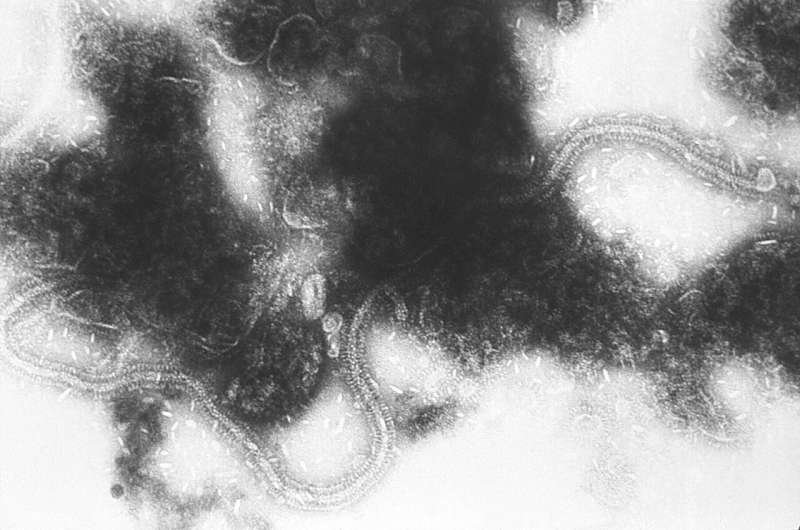This article has been reviewed according to Science X's editorial process and policies. Editors have highlighted the following attributes while ensuring the content's credibility:
fact-checked
trusted source
proofread
New report details success last winter in caring for critically ill children amid severe RSV surge

A new report published in the journal Pediatric Critical Care Medicine shares insight on the use of the Oregon Medical Coordination Center, or OMCC, to manage recent surges in pediatric critical care patients.
Last winter's surge in respiratory illnesses—which led Oregon's governor to declare a public health emergency in Oregon and regional hospitals to operate under crisis standards of care—spotlighted the practical value of the coordination system spearheaded by Oregon Health & Science University.
"During the past several years, managing both COVID-19 and this recent surge of respiratory viruses, we have seen the urgent, increasing need for centralized resources and real-time coordination of care," said Matthias Merkel, M.D., Ph.D., OHSU senior associate chief medical officer for capacity management and patient flow. "As the U.S. faces ongoing challenges with health care resources and staffing, OHSU will continue to innovate and advance statewide collaboration, so all Oregonians can receive the care they need."
Created by OHSU in 2021, in partnership with the Oregon Health Authority and other state health systems, the OMCC coordinates transfers among hospitals when patients are unable to receive necessary care where they were originally admitted.
OMCC uses the Oregon Capacity System, a real-time data tracking tool developed by OHSU to provide a comprehensive view of hospital occupancy and bed and resource availability across the state. The center's centralized coordination and surveillance aims to better connect fragmented, under-resourced health services and improve access to care for Oregonians.
An unprecedented surge
Last fall and winter, the United States experienced a convergence of multiple respiratory illnesses, including RSV, the flu and COVID-19, which severely impacted both adults and children—especially those younger than 2. This surge of illnesses hit the Pacific Northwest particularly hard: Between Nov. 1 and Dec. 14, 2022, all pediatric hospital resources in Oregon and Washington operated over their usual capacity, requiring hospitals and staff to go above and beyond, stretching resources to ensure all children received the care they needed.
During this time, many children required advanced respiratory care, and OHSU Doernbecher Children's Hospital and other hospitals were faced with an overwhelming number of young patients. This created challenges for care teams because many hospitals, especially those in rural areas, did not offer the specialty care needed by these seriously ill children.
Even more concerning was the risk posed to patients, who were facing significant delays in receiving potentially life-saving care. Without centralized coordination during these surges, patients are sometimes sent great distances—often states away—to receive care, which creates a difficult and distressing situation for patients and their families.
A coordinated, centralized response
In response to this crisis, OMCC teams, including specially trained nurses from OHSU Mission Control, coordinated among Oregon's children's hospitals and beyond to find treatment for critically ill children—even as pediatric intensive care units were overflowing.
Because OMCC provides a real-time, comprehensive view of the state's health care resources, clinicians and leaders were able to see how the state was managing its current patient load and could coordinate to ensure patients were treated as quickly and as close to home as possible.
In addition to describing OMCC's growth and adaptation, the new report highlights additional changes to meet pediatric patient needs during this recent surge, including: load balancing through surveillance; modifications of existing referral agreements; coordinated expansion of resources; activation of regional crisis standards of care; and integration of pediatric critical care physicians as subject matter experts.
These efforts were critical in helping clinicians, health leaders and policymakers better allocate resources during the surge and ultimately saved the lives of many young Oregonians.
"Our commitment to the community is to take care of as many patients as we can, especially those who need our specialized services," said Carl Eriksson, M.D., M.P.H., OHSU Doernbecher Children's Hospital medical capacity officer. "These coordination efforts are critical for the health of Oregonians because they ensure that children have access to life-saving services when needed and help us maximize the impact of our resources."
The recent surge occurred in pediatric systems already severely constrained from pandemic-related impacts, including significant staffing shortages. In addition to taking emergency measures to increase and stretch resources, Eriksson said it's essential to make the most of what is available by efficiently coordinating between clinicians.
More information: Steven H. Mitchell et al, Using Two Statewide Medical Operations Coordination Centers to Load Balance in Pediatric Hospitals During a Severe Respiratory Surge in the United States, Pediatric Critical Care Medicine (2023). DOI: 10.1097/PCC.0000000000003301


















